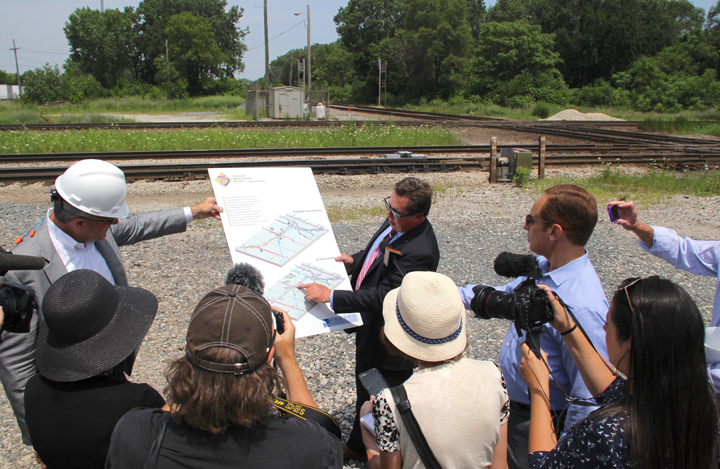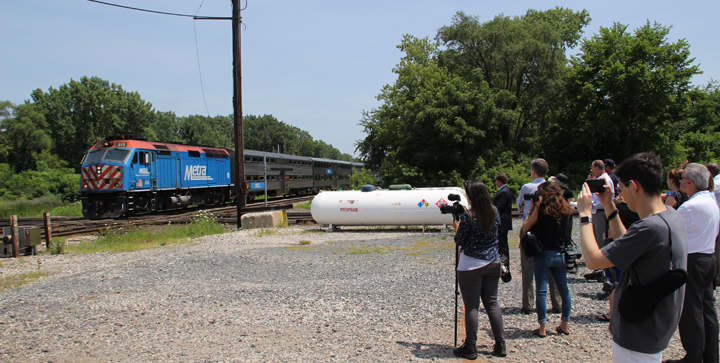
CHICAGO — The beginning of the end is near for the most congested rail chokepoint in the nation’s busiest rail hub, Chicago area transportation officials say.
Funding is finally in place to begin design work on the Forest Hill Flyover on Chicago’s South Side, where four Belt Railway of Chicago, Norfolk Southern, and Metra tracks are crossed at grade by CSX Transportation’s two-track Blue Island subdivision.
The breakthrough came in June with the U.S. Department of Transportation’s award of a $132 million Infrastructure or Rebuilding America (INFRA) grant.
On Wednesday, officials from the state, Cook County, city of Chicago, Metra and Amtrak heralded their public-private partnership with six freight railroads in a program called CREATE, for Chicago Region Environmental and Transportation Efficiency. They sponsored a media tour to call the public’s attention to benefits that will derive from the grant money.
“This is the start of something big,” says Randy Blankenhorn, Illinois Department of Transportation secretary. “This (funding) investment will pay huge benefits over the years.”
The Forest Hill Flyover and four adjacent projects comprise the 75th Street Corridor Improvement Project, on the city’s South Side, which is designed to alleviate congestion by separating freight and passenger rail lines to eliminate bottlenecks, reduce delays, cut train idling and improve reliability for commuters and freight traffic.
The corridor sees much of the 1,300 to 1,400 train movements through the Chicago area daily, officials said.
Specifically, the Forest Hill Flyover will eliminate conflicts between 30 SouthWest Service Metra trains and some 35 freight trains operating on CSX’s Western Avenue Corridor. The CSX tracks will be elevated over the Belt, NS, and Metra tracks.
Metra commuter trains will no longer be delayed by freight trains at the junction, and trains will no longer be held up by the “Chicago Protocol,” which limits freight movements during morning and evening hours to facilitate commuter trains, says Bruce Marcheschi, Metra’s chief engineering officer.
Metra will also benefit from construction of an additional main line, and SouthWest Service will connect with the existing Rock Island District tracks, allowing SouthWest Service trains access to LaSalle Street Station instead of Union Station, he says.
The design process is estimated to take two years, with construction taking another two years, says Bill Thompson, chief engineer for CREATE for the Association of American Railroads, which is coordinating the railroads’ participation.
The corridor project also includes a new road/rail at-grade separation at 71st Street; and the Argo connections, a new double track connection and crossovers between the Belt Railway of Chicago and Indiana Harbor Belt/CSX line at Archer and 63rd streets in Summit, Ill.
All together, the project is estimated to cost $474 million. In addition to the INFRA grant, $116 million is coming from six railroads: BNSF, Canadian Pacific, Canadian National, CSX, Norfolk Southern and Union Pacific. The state of Illinois is providing $111 million; Cook County, $78 million; and Chicago, $9 million. Finally, Metra is funding $23 million and Amtrak is providing $5 million.
Separately, construction is set to begin on a $65-million grade separation on Columbus Avenue, about a mile from Forest Hill.
Of the 70 CREATE projects, 29 have been completed at a cost of $1 billion, Thompson says. The price tag for all CREATE projects will run about $4.4 billion.
Perhaps the highlight of CREATE so far is the 2014 completion of the $142 million Englewood Flyover, which carries Metra Rock Island Line trains over the tracks used by approximately 60 NS freight and 14 Amtrak trains a day.
“Our goal has been to ensure that the partners, including the railroads, contribute commensurate with their benefits,” Thompson says.
















About Time! Boardman proposed this project and Amtrak, METRA, The Class 1s, and Obama did nothing! Belt Junction is the busiest junction in the United States every day 200 trains go through here. Mergers resulted in all of Chicago’s bridges being closed and the tracks they are suppose to use abandoned. Surrounding Belt Junction are all of the yards owned by the Class 1s. To the North is UP Yard Center Yard and CSX Transports Bar Yard. This yard has a yard lead that goes right over 75th Street and Belt Junction on 4 diamonds. Because Belt Railway of Chicago and CSX use 75th Street as their interchange and the throat to their hump every 15 minutes the crossing is blocked. This is a problem because at that crossing is a fire station and Southside Fire Department needs to get out of their house to make calls and the crossing and yard lead goes right through their driveway. The solution CSX Transport and Belt Railway need to put in a bridge this way hump traffic heading to Bar and Belt Yard stays out of the junction. Southwest of the diamonds is NS Ashwood Yard. Past the yard lead and the interchange track is METRA Ashwood Station the problem here is METRA directional runs with NS southwest of here and their tracks end at Ashwood and go to single track to bypass the yard. The solution build another track so METRA does not get stopped. East of the diamonds is Belt Junction. This place is a choke point here every railroad meets and METRA and Amtrak get stuck and delayed. The solution remove Belt Junction from the picture and have the interchange at 80th. East of Belt Junction is 80th Street Junction here the tracks going to LaSal and Union Station are located as is UP’s Canal Yard. The problem is METRA does not go to LaSal METRA goes to Union Station. The solution UP goes back on the bridge to access Canal, METRA is removed from the picture and a ramp is built to the Engalwood Flyover, and NS has it’s own route into Ashwood. by fixing these problems Chicago keeps moving and no railroad is backed up. I will let Amtrak explain. https://www.youtube.com/watch?v=aer4P5jNrms
STEVEN BAUER not just trains emergency equipment also. CSX tracks go right through the driveway of the South Chicago Fire Department. When they go on call 71st street is blocked and emergency equipment gets hit. to fix this we need to take CSX out of the picture.
P. McNamara: Are these printed Schedules or like Amtrak, you have to go to a computer?
This project was a long time coming. I would have thought the engineering had been completed and ready for bid once the money came through. Supposedly this will allow full service on the Metra Southwest Line.
Mr. McNamara, the terms “protocol” and “curfew” (or their equivalent meanings) have been used by Metra officials for at least the last 10 years, in my experience. At Metra board meetings and on its website, Metra provides detailed information on delays due to all causes, including freight train interference. In fact, Metra breaks down the numbers quite specifically for the SouthWest Service Line that would benefit from the Forest Hill Flyover. If the protocol is being routinely or flagrantly violated, I’m sure Metra board members would be screaming quite publicly. When freight trains do interfere with passenger trains during rush hours, it generally appears to be the lingering result of an earlier breakdown or other issue. Finally, I know from personal experience that the first BNSF freight moves through the west suburbs each day starting around 9:45 am. Thanks for reading.
“Chicago Protocol” ?
With a straight face, Richard Wronski uses a term that has NEVER been heard or used among the managers and dispatchers of Chicago area freight haulers since Robert A. Drengler was the Suburban Division Manager for the Chicago & North Western.
Drengler was the man who pioneered and rigidly enforced a total freight CURFEW that PROHIBITED freight movements from 5 thru 9AM and 2 thru 7PM anywhere NEAR main lines that carried their bi-level commuter Streamliners.
Freight has been KING among ALL the freight lines emanating out of city center since Union Pacific’s entry into Chicago in 1995, and to pretend otherwise, or to make up silly terms for a wishful situation where the rail Barons think silly commuter trains should affect their precious freight cargo, is less than honest.
Go sit at ANY suburban train station and see how close to schedule the trains arrive to pick up passengers – and get back to me how close to the published schedule they are !
“When freight trains do interfere with passenger trains during rush hours, it generally appears to be the lingering result of an earlier breakdown or other issue.”
Given what I have seen out there every day (from behind the windshield), I will side with Mr. Mcnamara on this one.
The biggest beneficiaries of this project are the freight railroads yet they are going to pay a measly 25% (approx.) of the project.
About time. I can’t believe this wasn’t one of the first projects funded, considering how many conflicts are involved here.
This is awesome news and great news. I ran into a long story about this project in a Chicago newspaper web site when I was looking up something else. Hopefully this will help force a total rebuild of LaSalle Station.